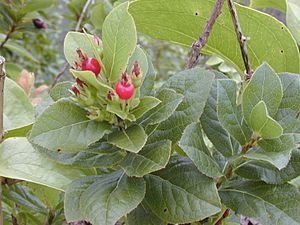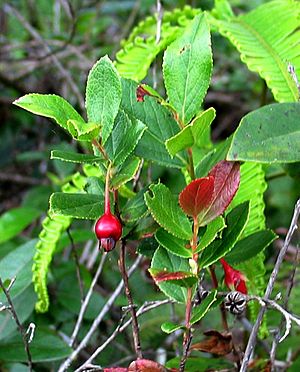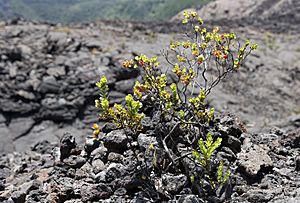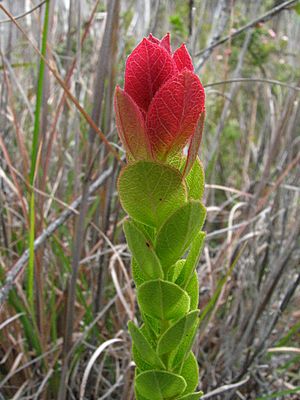Hawaiian Vaccinium facts for kids
Quick facts for kids Hawaiian Vaccinium |
|
|---|---|
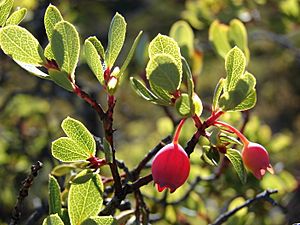 |
|
| Scientific classification |
|
| Kingdom: | Plantae |
| Clade: | Tracheophytes |
| Clade: | Angiosperms |
| Clade: | Eudicots |
| Clade: | Asterids |
| Order: | Ericales |
| Family: | Ericaceae |
| Genus: | Vaccinium |
| Clade: | Hawaiian Vaccinium |
Hawaiian Vaccinium are special types of blueberries found only in the Hawaiian Islands. They are a group of three species: Vaccinium reticulatum, Vaccinium dentatum, and Vaccinium calycinum. People in Hawaii call them ʻōhelo. These plants are unique because they have well-developed parts around their flowers (called calyx lobes) and longer flower tubes. Their flowers are more like cylinders than bells.
Unlike many other blueberries, Hawaiian Vaccinium plants keep their leaves for a very long time. They grow as shrubs, usually 1 to 6 feet tall, but sometimes up to 10 feet. You can find them all over the Hawaiian islands, from high up in the mountains (500 to 3,700 meters). They grow well in many different plant areas. However, Vaccinium reticulatum especially likes to grow near lava flows.
The berries of these plants can be red, yellow, black, or blue. Their flowers can be white, red, pink, or green. The leaves also come in different shapes and sizes. Vaccinium reticulatum and Vaccinium dentatum are evergreen, meaning they keep their leaves all year. But Vaccinium calycinum is deciduous, meaning it loses its leaves for a short time each year. All three species usually have flowers and fruit throughout the year. The most flowers and fruit appear from May to July. These plants can also cross-pollinate with each other, creating many different types of hybrids. They can also self-pollinate, which means they can make seeds using their own pollen.
Contents
How Hawaiian Blueberries Evolved
Scientists believe these Hawaiian blueberries came from a group of Vaccinium plants that started in North America. However, we don't have strong proof for this idea yet. The Hawaiian Islands are famous for "adaptive radiation." This is when one type of plant or animal quickly changes into many new species. This happens because the islands are isolated and have many new places for plants to grow. Plants that go through adaptive radiation often become very specialized. They might only live on one island or in a small area. They also often lose their ability to spread their seeds far away.
But Hawaiian Vaccinium plants are different. They are found all over the Hawaiian islands. They have also kept their ability to spread their seeds widely. This suggests they might have arrived in Hawaii more recently than other plants. Another interesting thing is that these plants can self-pollinate. This means a single plant can make seeds on its own. This is rare for other Vaccinium plants around the world. While all three Hawaiian species can self-pollinate, the seeds from self-pollination are not always strong. For example, Vaccinium calycinum is very good at self-pollinating. But Vaccinium reticulatum and Vaccinium dentatum have less successful seeds when they self-pollinate.
The history of the larger Vaccinium plant group is a big puzzle for scientists. Plants that are genetically related don't always look alike. They also don't always grow in the same places. This makes it hard to know exactly how Hawaiian Vaccinium evolved. But scientists are fairly sure that all Hawaiian Vaccinium species came from a single common ancestor.
The Mystery of Vaccinium cereum
Hawaiian Vaccinium was once grouped with a mysterious plant from the South Pacific called Vaccinium cereum. Scientists are still debating where these four species truly belong in the plant family tree. Vaccinium cereum is different from the Hawaiian species because it has a special kind of ovary (the part that holds the seeds). This ovary is more like those found in Asian Vaccinium species. The Hawaiian species have a simpler ovary structure.
For a long time, people thought that Vaccinium cereum was the ancestor of the Hawaiian blueberries. But new genetic studies suggest that the Hawaiian plants are more closely related to a North American group. This means Vaccinium cereum might actually be a hybrid plant. It could be a mix of Vaccinium calycinum (one of the Hawaiian species) and an East Asian species called Vaccinium fragile. If this is true, it would mean Vaccinium cereum is a mix of plants from the Americas and the Asia. This is an exciting idea, but there is still much to learn about the history of South Pacific Vaccinium plants.
Vaccinium cereum: A South Pacific Hybrid
It's important to know that V. cereum is not found in Hawaii. It grows on islands in the South Pacific, like the Cook Islands, Tahiti, and the Marquesas Islands. It grows at high elevations. Vaccinium cereum has a unique ovary and a complex flower structure. These features are usually found in East Asian Vaccinium species, not Hawaiian ones.
Even though Vaccinium cereum looks similar to Hawaiian plants in some ways, it always keeps that special ovary. This ovary is a key feature of East Asian species. The appearance of Vaccinium cereum can vary a lot from island to island, and even from plant to plant on the same island. For example, the hairiness, waxy coating, and fruit and flower colors can all be very different. One scientist even found a single Vaccinium cereum plant that had every type of flower structure he had ever seen on any Vaccinium plant in the world!
Meet the Hawaiian Blueberry Species
Vaccinium reticulatum
Vaccinium reticulatum is an evergreen shrub that grows from underground stems. It has stiff, upright branches that are often hairy. Its leaves are oval-shaped, about 1-3 cm long and wide. They often have hairy or jagged edges. The berries are 9-14 mm wide and can be bright red, yellow, orange, purple, or blue. The flowers are 8-12 mm long and can be red, yellow, yellow with red stripes, or greenish-yellow. They can be bell-shaped or cylindrical. There are many different types of Vaccinium reticulatum. Some types with specific leaf shapes are only found on certain islands.
Vaccinium reticulatum is different from Vaccinium dentatum and Vaccinium calycinum. Generally, all its parts are smaller and more compact. Its leaves are thin and papery, while the other two species have thicker, leathery leaves. Vaccinium reticulatum is often one of the first plants to grow in new areas, like lava flows, ash dunes, or cinder beds. This might be because of its unique features. It is often found at higher elevations, up to 3,700 meters. You can find Vaccinium reticulatum mostly on Maui and Hawaii Island. It is less common on older islands like Kauai, Oahu, and Molokai.
This species takes about 5 years to bloom after its seed sprouts. This is much longer than the other two species. It flowers throughout the year, but mostly twice a year. A key way to tell Vaccinium reticulatum apart is its short, thick flower stems (called pedicels), which are 0.5-1.5 cm long. While other features vary a lot, the pedicel length is a good clue. Vaccinium reticulatum is very diverse in how it looks. Some scientists even thought it might be a mix of many different parent plants. But now, most agree it's a single species.
Vaccinium dentatum
Vaccinium dentatum usually grows low to the ground or spreads out. It is 0.3 to 3 meters tall. You can find it in open areas like bogs, swamps, or windy ridges. It tends to grow at lower elevations than Vaccinium reticulatum, from 700 to 1,200 meters. It is found on all the main Hawaiian islands. Its leaves are usually oval-shaped, 4-9 cm long and 1-3 cm wide, with jagged edges and are usually smooth. The flowers are less varied than in V. reticulatum: they are red or pink with greenish tips, 9-12 mm long. The berries are usually bright red and 8-10 mm wide. This species flowers and fruits all year. Vaccinium dentatum takes 2-3 years to bloom after its seed sprouts.
The main way to identify Vaccinium dentatum is its pedicel length, which is 1-3 cm long. You can usually spot Vaccinium dentatum by its red berries and typical leaf shape, as well as where it grows. However, because some of these features can also be found in Vaccinium reticulatum, it's important to be careful when telling them apart. That's why the pedicel length is so helpful.
Vaccinium calycinum
Vaccninium calycinum is a stiff, upright deciduous shrub, 1-5 meters tall. It grows at similar elevations and locations as Vaccinium dentatum: 500-1,800 meters, on all main islands. We don't know for sure if these two species grow together. Its leaves are more like Vaccinium dentatum than Vaccinium reticulatum: they are oval, smooth, and have jagged edges. But they are the largest of the three species: 5-8 cm long and 2-4 cm wide. The corolla (flower petals) can be solid green, yellowish-green, or reddish-green, and are 9-12 mm long. The berries are always bright red and 9-15 mm wide. It can flower and fruit all year, but more often in the summer.
The most unique thing about Vaccinium calycinum is that it is deciduous. This means it loses its leaves for a short time, usually 1-3 weeks from October to February. Vaccinium calycinum can bloom just 9 months after its seed sprouts. This is the fastest maturity rate of the three species.
Like with Vaccinium dentatum, some features of Vaccinium calycinum (like red berries and jagged leaf edges) can also be found in Vaccinium reticulatum. So, you need to be careful when identifying them. The special feature for Vaccinium calycinum is its calyx (the green leaf-like parts that protect the flower bud). In Vaccinium calycinum, these parts are leafy and overlap in the bud. They are also 2-3 mm wide at the base and longer than the flower tube when the flower is open.
Images for kids


